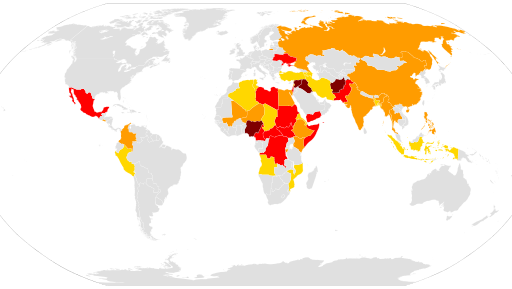GLOBAL. Estimates show that probably about 70,000 people have been killed in 52 armed conflicts that are taking place around the globe this year and three times more have died in the last year’s fighting. In total, an estimated 6,300,000 lives were lost worldwide since current armed conflicts began. Yet combats have kept escalating for religious, economic or political frictions while peace agreements have steadily losing ground for many to reach final agreements. In the past decades, the amount of wars and fights has fluctuated from year to year but some of the longest lasting conflicts remain unsolved.
Since its beginning in 1948, the Israeli-Palestinian conflict has the roots in the disputes over the territory of Gaza Strip and the religious identity issues between Palestinian Jewish and Arabs tied up with land; years of tensions after the start of the First Intifada, a Palestinian uprising against Israeli occupation in 1987, have led to the deaths of 10,000 people, eight of whom may have died this year.
The war in Afghanistan is divided into four phases, the first of which began in 1978 as a result of the conflict between anti-Communist Muslim Afghan guerrillas and the Afghan government aided by the Soviet forces followed by the Taliban civil war and 2001 US led invasion linked to the September 11 attacks. At the end of 2014, NATO has transferred security functions to the Afghan government, marking a new phase. Estimated fatalities vary as Afghanistan has never conducted a full census. Some of the available figures show that between 1,24 million and 2 million people were killed before 1992 and more than 26,000 from 2001 to 2011. The Afghan clashes may have left 13,000 dead in the last five months.
The human cost of the Iraqi civil war that started in 2003 can be count in hundreds of thousands of lives, based on available dates. According to Iraq Body Count, an independent UK-US group, the death toll exceeds 200,000, from 2003 to present; including 7,000 fatalities occurred in the first half of this year. The armed conflict escalated since the withdrawal of U.S. troops in 2011 due to territorial gains by the Islamic State and operations by Iraqi security forces, as well as ongoing Sunni-Shia sectarian group.
Although relatively new, the four-year Syrian civil war is the world’s most brutal conflict over the past two years. The battle between opposition groups and forces loyal to the President Bashar al-Assad as well as jihadist militants from Islamic State of Iraq and the Levant claimed a total of more than 320,000 lives including nearly 23,000 fatalities suffered this year.
Since long time many of the African nations have experienced armed conflicts and endured casualties. The war in Darfur region of Sudan broke out in 2003 when rebel groups began attacking government for oppressing blacks in favor of Arabs. The United Nations has stopped keeping track of the death toll in Darfur but said up to 300,000 people may have died from the combined effects of war, hunger and disease since the start of the conflict; more than 800 people lost their lives this year, according to the Armed Conflict Location and Event Data Project. Sudanese officials put the death toll at 10,000.
In Somalia, almost 260,000 people are estimated to have been killed by famine and another 290,000 in clashes between 2010 and 2012, revealed a UN report in 2013. Estimates of the overall added more than the 220,000 deaths during Somalia’s 1992 famine and about 1,400 Somalis who died this year. Somali civil war started in 1991 when the clan-based warlords ousted the nation’s long-standing military government; in 2009, a new phase of the war began with the conflict between forces of the Somali government and various militant Islamist groups.
Nearly decade-long North American drug war between the Mexican government and various drug trafficking cartels has caused many victims. There have been more than 120,000 intentional murders between December 2006 and November 2013, has indicated the Mexican government. Many of the violent acts could be attributed to drug-related fighting but is unclear the way people have died. During an official visit to Ottawa three years ago, former US Secretary of Defense Leon Panetta said about 150,000 people have been killed in Mexican drug war, based on dates provided by the officials of Mexico. Soon after, the government of Mexico has corrected Panetta’s sayings and it has been specified that criminal groups left these people dead in all the countries of the American continent, not just in Mexico. According to Mexico 2014 Crime and Safety Report published by the Overseas Security Advisory Council of the US Department of State, the violence in fighting among drug gangs, particularly in Mexico City, has been on the rise over the last decade. More than 15,000 assassinations have been committed during the last year, without being specified drug-related ones, by the Mexican National Security System. Lantia, a security consultant firm, estimated to nearly 1,800 executions related to organized crime have been carried out so far this year.
A major threat to Europe lies in Ukraine since last year. Following the Russian annexation of Crimea, separatist forces have engaged in the armed conflict in the Donbass region with the Ukrainian government. Estimates of people killed since fighting broke out in last April vary to between 6,400, according to the United Nations and 10,000 fatalities appreciated by self-proclaimed “People’s Governor of Donbass Region” Pavel Gubarev.
Could bloody fights no longer knock out diplomatic tools?
The international community has made attempts to help solve some of world’s current conflicts, but nothing seems to have worked; either the representatives of conflicting parties refused to negotiate and to come up with compromise solutions or peace deals were not respected later on. On the other hand, some experts said the failure of diplomatic efforts is often caused by wrong approaches to conflicts. World powers still try to agree a strategy on how to deal with ongoing armed conflicts.

